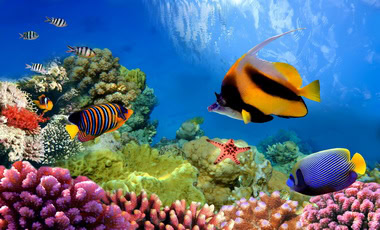The claim that higher temperatures will kill off the world’s corals is irresistible to global warming activists. They understand the emotional appeal of the reefs and their bright-colored fishes. Greenpeace, perhaps predictably, has been quick to play this card:
”The Philippine coral reefs, among the most diverse and largest in the world, may not be around for long. … On the last day of the symposium [at Bali] the environmental group Greenpeace released a new coral reef study showing that, because of the global warming, the Pacific Ocean could lose most of its coral reefs by the end of the current century.” (385)
The only problem with the ”disappearing coral” theory is that it is false. Corals date back 450 million years, and most of today’s coral species date back at least 200 million years. Just in the last two million years, coral reefs have been through at least seventeen glacial periods, interspersed with their warm interglacial periods. These glacial-interglacial shifts imposed repeated dramatic temperature changes, along with sea level changes as drastic as four hundred feet.
Temperatures across the Pacific change sharply with the El Nino-Southern Oscillation (ENSO)-which causes a major Pacific temperature change every four to seven years. The 1998 El Nino boosted sea surface temperatures all over the Pacific, causing massive coral bleaching, especially in the Indian Ocean. That’s when Mark Spalding, supposedly a coral expert, claimed that the vast majority of the corals had died out. (386) Bleaching is a part of corals’ strategy for adapting to their almost-constant temperature changes. (387)
Ross J. Jones of Australia’s Queensland University reported coral bleaching on a portion of the Great Barrier Reef just after average daily sea temperatures rose by 2.5 degrees Celsius in eight days. (388) However, Canada’s D.R. Kobluk and M.A. Lysenko found severe coral bleaching in the Caribbean after the water temperature declined 3 degrees Celsius in eighteen hours. (389)
New studies tell us that bleaching is the coral system’s way of dealing with sudden temperature changes. Cynthia Lewis and Mary Alice Coffroth of the University of Buffalo deliberately triggered bleaching in some coral colonies. In response, the colonies ejected 99 percent of their symbiotic algae friends. The researchers then exposed the bleached coral to a rare variety of algae that wasn’t in the coral colonies at the beginning of the experiment. Sure enough, within a few weeks, the corals had substantially restocked their algae shelves, and about half included the new marker algae. Later, the marker variety was displaced from several of the coral colonies by more effective algae strains-indicating that corals pick the best partners for the new conditions from the wide variety of algae floating in their part of the ocean. (390)
Lewis and Coffroth say this is a healthy demonstration of flexibility in coral colonies. They say coral systems have the flexibility to establish new associations with algae strains from the whole environmental pool and that is ”a mechanism for resilience in the face of environmental change.” (391)
In the same June 2004 issue of Science, Angela Little of Australia’s Cook University and Madeline van Oppen of Australia’s Institute of Marine Science echoed the findings of Lewis and Coffroth. They attached titles to various parts of the Great Barrier Reef in Australia and studied the algae recruited by the juvenile corals that grew on them. They found that the young corals were likely to try any algae— ”a potentially adaptive trait.” (392)
Eco-activists and biologists who claim global warming is killing corals are wrong-again. Science has returned its verdict on corals and global warming: No Link.
(385) Report from the 9th International Coral Reef Conference, Bali, 23 June 2003.
(386) Samanta Sen, ”Disappearing Coral Reefs Also a Human Loss,” Interpress News Service, September 13, 2001.
(387) Jeff Hecht, ”Corals Adapt to Cope With Global Warming” NewScientist.com, August 11, 2004.
(388) R. J. Jones et al., ”Changes in Zooxanthellar Densities and Chlorophyll Concentrations in Corals During and After a Bleaching Event,” Marine Ecology Progress Series 158 (1997): 51-59.
(389) D. R. Kobluk and M.A. Lysenko, ”Ring Bleaching in Southern Caribbean Agaricia Agaricites During Rapid Water Cooling,” Bulletin of Marine Science 54 (1994): 142-50.
(390) C. L. Lewis and M.A. Coffroth, ”The Acquisition of Exogenous Algal Symbionts by an Octocoral After Bleaching,” Science 304 (2004): 1490-491.
(391) Ibid.
(392) A. F. Little et al., ”Flexibility in Algal Endosymbioses Shapes Growth in Reef Corals,” Science 305 (2004): 1492-94; Kobluk and Lysenko, ”Ring Bleaching in Southern Caribbean Agaricia Agaricites During Rapid Water Cooling,” 142-50.

